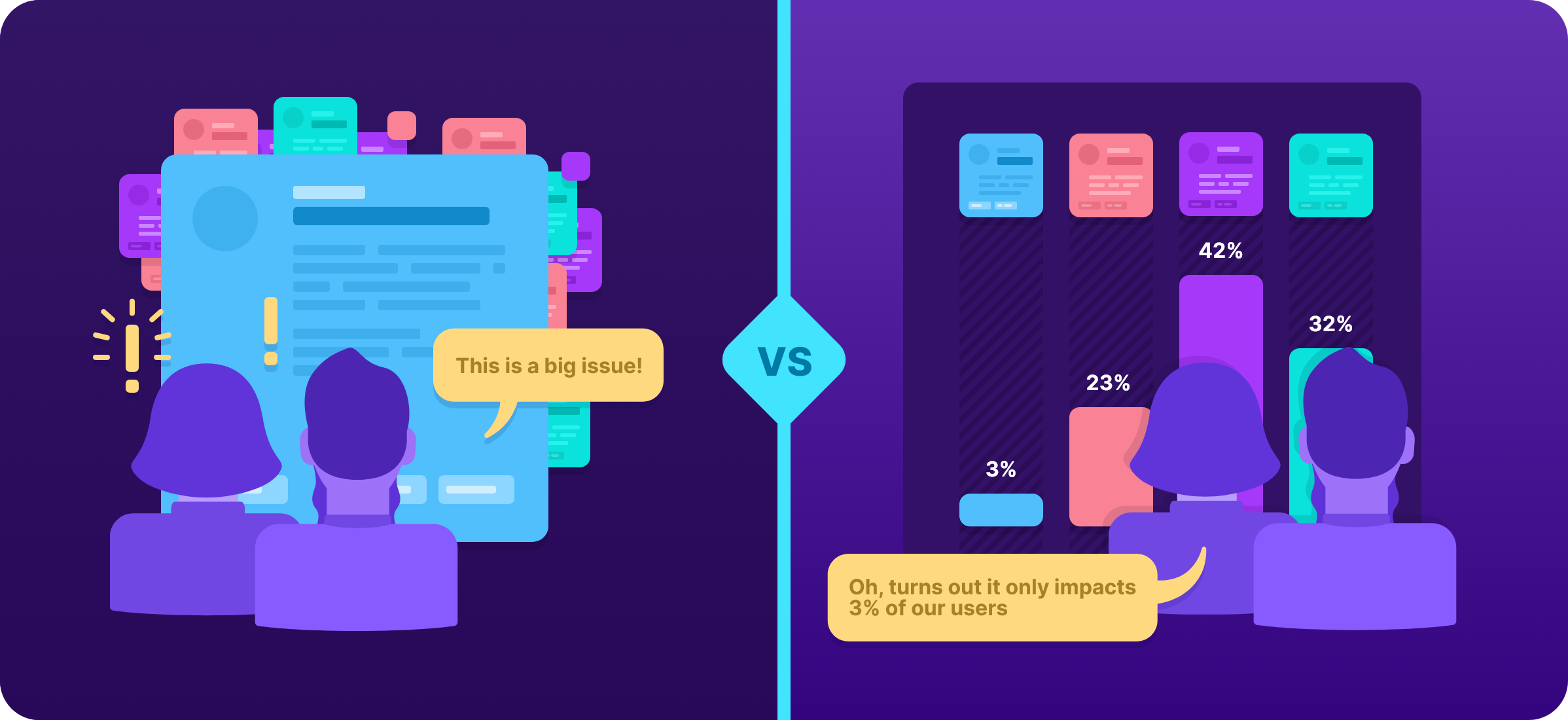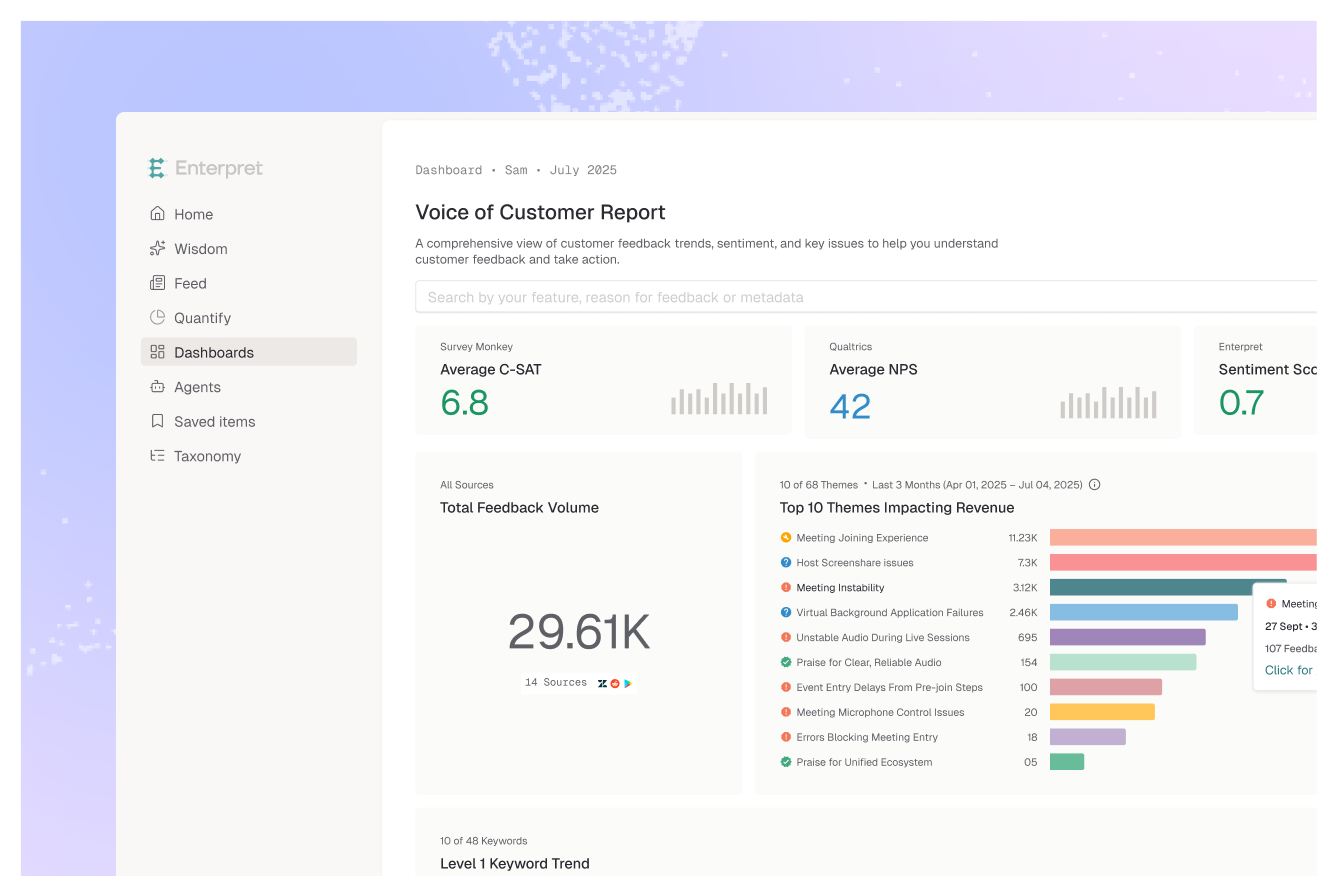4 ways your product feedback loop is broken
Hi I'm Jack! Since joining Enterpret, I have had the opportunity to speak with product leaders across multiple industries about how they manage and make use of their customer feedback. Each of these teams recognizes that feedback from their customers is paramount to the success of their products, but they have taken a wide range of approaches to learning from their customer feedback—to varying degrees of success.
As the world of SaaS products moves more and more to product-led sales motions it is more important than ever that product teams listen to, and learn from, their customer feedback. I wrote a Voice of Customer Maturity model that acts as a playbook if you're looking for a more tactical guide!
In this article I’ll discuss the 4 most common mistakes that I see product teams making when it comes to learning from their customer feedback.
- Your customer feedback is all over the place
- You are not quantifying your qualitative feedback
- You consider all customer feedback equal
- You’re wasting your time on manually intensive solutions
Your customer feedback is all over the place
Its 2024 and your customers have 6+ ways of getting in touch with you:
- Social media
- App store reviews
- Support tickets
- Sales calls
- In-app surveys
- Consumer rating services
- Customer and industry communities
At most tech companies each of these channels is managed and supported by different teams. If you are only looking at one, or a few, of these sources then your thinking will inherently be biased towards those users and you’re missing out on valuable information. Even if you have set up a solution to forward these conversations to a shared Slack channel, you are still going to have biases based on what you read and when - are you really taking the time to read through every single ticket?
The best teams take a holistic view of all their different feedback sources so they can have a complete understanding of their customers. By having a centralized system of customer feedback, they know that they are not missing any important trends or giving in to biases by only listening to certain types of customers.

You are not quantifying your qualitative feedback
Many product teams succumb to building products for their loudest detractors, or the most recent bug report, and do not take a data-driven approach to understanding their customer feedback. If you are not quantifying your qualitative feedback you are letting your biases make your decisions for you.
By taking a data-driven approach you can focus on building what will have the largest impact on your business by knowing, not guessing, what is most important to your customers.

You consider all customer feedback equal
Was that random tweet from a user at a million-dollar customer who is at risk to churn? Was that scathing support ticket from one of your customers who just upsold?
Once you have a holistic view of everything your customers are saying and how often they are saying it, it is critical to understand who is saying it as well. This can be done through traditional cohorts (e.g. paid vs. unpaid and enterprise vs. mid-market), but truly data driven teams also do this by combining your customer feedback trends with your product analytics, which allows you to see:
- What your power users are saying and what's holding back your casual users from reaching that level.
- What your churned users were saying before they left. Do you have active customers struggling with similar things?
- If you want to increase expansion into a new market, what do your existing customers there love about your product?
By understanding what's most important to different groups of user you can make informed decisions to best meet their unique needs.

You’re wasting your time on manually intensive solutions
Even the best teams with committed customer feedback strategies often rely on manual tagging to categorize and aggregate what their customers are saying.
Is your support team compensated for how accurately they tag a ticket? Or is it on how quickly and effectively they help your customers? What happens when you add a new tag; do you go back and re-tag every piece of feedback you’ve ever gotten? What if a new feature request is only seen once by each support agent?
For your product and engineering teams, how much time do you spend reading through customer support tickets? Is that a high leverage activity for your time?
By automating the time that would otherwise be spent triaging support tickets, reading through community conversations, listening to recorded customer call, and then aggregating everything you saw in a spreadsheet, you open up hours every week for your team to spend on their core, value-adding, jobs.
Modern machine learning algorithms are capable of fully understanding topics, intent, and sentiment of written text at levels that match, and often exceed, human capabilities. Taking advantage of machine learning can help create a robust understanding of what your customers are saying in a fraction of the time it would take a human to review a similar-sized dataset.

What makes an excellent strategy for customer feedback analysis?
Every product team wants to be customer-centric, but it’s easier said than done. By following these 4 principles you can feel confident that your customer feedback strategy is going to help you do just that.
- You have a single source of truth for all customer feedback that allows you to see trends and insights no matter where they are coming from.
- You take a data-driven approach to confidently know what your highest impact issues and opportunities are.
- You know what is important to every different type of customer and can make decisions based on business impact.
- You have an automated solution that gives you the highest possible degree of confidence and allows your team to focus on high-leverage activities.
Run exceptional feedback loops with a Voice of Customer strategy
Having a Voice of Customer strategy in place can help your team to never lose sight of who you're building for. Customer feedback is invaluable and listening actively and iterate swiftly on feedback helps teams to exceed customer expectations.
At Enterpret we support teams in building out their Voice of Customer programs by:
- Unify feedback all sources
- Create an automated and adaptive taxonomy
- Offer flexible analytical interfaces to help teams understand the Voice of Customer
If you want to build a Voice of Customer program and want help, get in touch - we’d love to share how Enterpret can help.
Or check out our VoC Template Library to see how the best product teams are building their Voice of Customer Programs.














